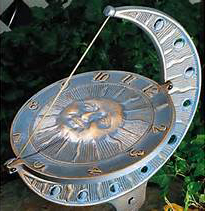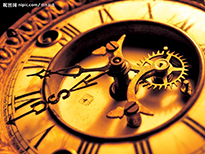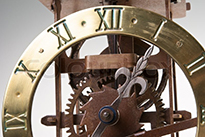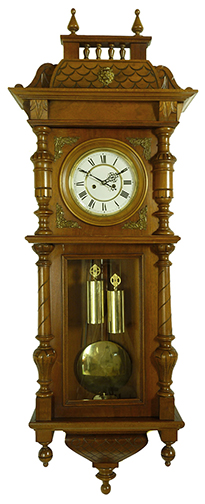BEGINNINGS / THE HISTORY OF CLOCKS
Humankind has always recognized the passing of time, and has tried to measure and recorded that passing The simple alarm clock at your bedside table owes its existence to more than 6,000 years of thinking about time and tinkering with devices to accurately mark its passage. The history of clocks dates back over many centuries. The actual date for the first clock is disputed among historians, but they do agree that the word ‘clock’ was first used in the 14th century. The word ‘clock’ is derived from the Latin ‘clocca’ meaning bell.
 The first methods for telling the time relied on the movement of the sun across the sky. When the sun was directly overhead it was the middle of the day or ‘noon’, and when it was on the horizon it was early morning or early evening, depending if it was in the east or the west. This method was not very accurate, but nevertheless it has been used for countless years from early man, right through to today.
The first methods for telling the time relied on the movement of the sun across the sky. When the sun was directly overhead it was the middle of the day or ‘noon’, and when it was on the horizon it was early morning or early evening, depending if it was in the east or the west. This method was not very accurate, but nevertheless it has been used for countless years from early man, right through to today.
 A general knowledge of time division was relevant to the earliest of farmers who sectioned quadrants of time into broad periods of seasons for planting, growing and harvesting. In those days, however, the actual hour of any particular day was not important.
A general knowledge of time division was relevant to the earliest of farmers who sectioned quadrants of time into broad periods of seasons for planting, growing and harvesting. In those days, however, the actual hour of any particular day was not important.
As early civilizations grew and became more complex in their needs for order and governance, a more precise measure of time was required. The early Egyptians originated the division of each day into two measurable parts, using the position of an obelisk’s shadow to mark high noon. Other early and more precise timekeeping devices also include the hourglass, indexed candles that burned at a fixed rate, and water-powered devices.
EARLY MECHANICAL CLOCKS
 In medieval times, the regulation of monastic calls to prayer was accomplished by means of mechanical tower clocks. This revolutionary device soon synchronized the rhythms of entire cities. World views of entire cultures were influenced by the type of clocks they used. The development of atomic clocks, accurate to a billionth of a second, seem to reflect modern society’s near obsession with youth, age and the passage of time.
In medieval times, the regulation of monastic calls to prayer was accomplished by means of mechanical tower clocks. This revolutionary device soon synchronized the rhythms of entire cities. World views of entire cultures were influenced by the type of clocks they used. The development of atomic clocks, accurate to a billionth of a second, seem to reflect modern society’s near obsession with youth, age and the passage of time.
 The very first early mechanical clocks, which didn’t have pendulums, were developed in the last half of the thirteenth century, probably by monks from central Europe, and were placed within the church. They did not have dials or hands and only struck bells on the hour. These mechanical devices were probably placed in the church belfry in order to make use of the existing church bell. It was aver 100 years before visible dials and hands were added. These early clocks were very large and were made of heavy iron frames and gears forged by the local blacksmiths.
The very first early mechanical clocks, which didn’t have pendulums, were developed in the last half of the thirteenth century, probably by monks from central Europe, and were placed within the church. They did not have dials or hands and only struck bells on the hour. These mechanical devices were probably placed in the church belfry in order to make use of the existing church bell. It was aver 100 years before visible dials and hands were added. These early clocks were very large and were made of heavy iron frames and gears forged by the local blacksmiths.
 In 1580 or so the astronomer Galileo Galilei observed a swinging lamp suspended by a long chain from a cathedral ceiling. He studied its swing and discovered that each swing was equal and had a natural rate motion. He later found this rate of motion depended upon the length of the chain or pendulum. Many years later in 1640 he designed a clock mechanism incorporating the swing of a pendulum, but he died before building his clock design.
In 1580 or so the astronomer Galileo Galilei observed a swinging lamp suspended by a long chain from a cathedral ceiling. He studied its swing and discovered that each swing was equal and had a natural rate motion. He later found this rate of motion depended upon the length of the chain or pendulum. Many years later in 1640 he designed a clock mechanism incorporating the swing of a pendulum, but he died before building his clock design. 
Later in 1656 Christiaan Huygens added a pendulum to a clock mechanism of his own design and found it kept excellent time. Regulating the speed of the movement was done, as it is today, by simply raising or lowering the pendulum bob: up, to speed up the clock; down, to slow down the clock — thus the terms ‘speed-up’ and ‘slow-down”. Note: the length of a pendulum is usually considered to be the length from the centre of the shaft that holds the hands to the centre of the pendulum bob. (Sometimes it is from the centre of the shaft that holds the hands to the bottom tip of the pendulum bob.)
Huygens’ invention allowed clocks to be accurate to as little as three minutes loss or gain per day, instead of the previous quarter to half an hour per day variance. The introduction of minute hands resulted from this increased accuracy. By 1670, with the introduction of the anchor escapement, time variance was decreased to as little as a few seconds per week.
By the first part of the fifteenth century, small domestic clocks started to appear. They were probably made by the local gunsmiths or locksmiths. After 1630, a weight-driven lantern clock became popular for the home use of the very wealthy. When the swinging pendulum was added in 1656, clocks became more accurate. Very early clock movements were mounted high above the floor because they required long pendulums and large cast-iron descending weights. In reality, they were nothing more than simple mechanical works with a face and hands. They were referred to as “wags-on-the-wall”. The long-case, or grandfather clock, actually evolved from these early wags-on-the-wall prototypes. Wooden cases were used only to hide the unsightly weights and cast-iron pendulum.
Although the Dutchman Hyugens’ innovative pendulum design brought a great leap forward in clockmaking, it was English clockmakers who reigned supreme in Europe from about 1660 to the early 19th century, when the Americans introduced inexpensive brass movements.